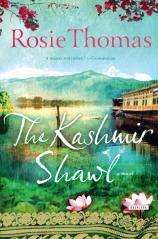Interview: January 10, 2013
Rosie Thomas has been writing acclaimed and beloved novels for over three decades. Her latest, THE KASHMIR SHAWL, is a runaway bestseller in London and is set to take America by storm. In this interview, conducted by Bookreporter.com’s Norah Piehl, Rosie talks about the pitfalls of attempting historical accuracy, the blinding beauty of Antarctica, and the difficulties of doing research in one of the world’s most dangerous places.
Bookreporter.com: THE KASHMIR SHAWL focuses on two women from two different generations --- Nerys in the 1940s and her granddaughter Mair in the present day. Was one of these characters easier to write than the other? How did you go about constructing their individual voices?
Rosie Thomas: Present-day voices are always a little easier to start with, because
the language and horizons are more familiar. I try to be careful about huge anachronisms, so when I’m finding a voice from a generation before ours, I go slowly, reading myself into it via history and fiction from the contemporary period and thinking about the different morals and social attitudes of the day. In THE KASHMIR SHAWL, the grandmother, Nerys, came from a background in rural north Wales very similar to my own family’s –-- so that made the early stages a little easier this time. By the end of the writing, I felt so fond of Nerys that she was almost more real in my head than the modern Mair.
BRC: The book’s chronology also shifts between these time periods. Can you tell us about the historical research you did to learn about this region in the 1940s?
RT: Quite a lot of background reading, mostly memoirs by wives of the Raj. The assumption is that they lived lives of great privilege and luxury, with squads of native servants and all the leisure and freedom in the world. Of course this is partly true --- but they were also isolated from their own culture, even more reliant on their men and conditioned by their status than wives back “home.” They were also separated from their children, and at the mercy of India’s climate. I also read memoirs by native Kashmiris, and social and political accounts of the time, and tried to knit all this together without making it sound too much like a history lesson! In Srinagar itself, I talked as much as I could to the older people about what the “old days” were like, and took several day tours of the old town, Moghul gardens, palaces, and one or two museums.
BRC: What can you share about the travel and research you did while writing the book? What was a memorable experience you had while traveling? How did your own experience of travel compare or dovetail with Mair's?
RT: I stayed on a houseboat on Lake Nagin, went boating in a shikara, wandered around the bazaar, sat in the old gardens and generally tried to immerse myself in the life of the city. I would half-close my eyes in an attempt to scrub out the modern traffic jams, pollution, mechanization, etc, and only to see the 1940s. I have to say that getting about and seeing what I needed to wasn’t always easy. The family I stayed with on the lake were traditional Muslims, and they were reluctant to send a middle-aged foreign lady wandering off on her own into areas that were not always “safe,” at least without one of the sons or brothers to accompany her.
In the end, I was able to meet and watch the weavers, spinners, dyers and embroiderers of the shawl trade (all of them male) in their workshops, and they were incredibly generous with their time and expertise. I found out such a lot about how fine shawls are made and sold, and the tradition they represent. But getting there took a certain amount of --- shall we say --- “persistence”? Kashmir did not feel to me like a dangerous place, but there is quite a lot of violence simmering below the surface. One night there was a power failure, and an outbreak of shooting just across the water in the bazaar. I lay in the darkness in my houseboat, thinking “why am I here and not in my bed at home???” But almost all the rest of the time, I thought Srinagar was one of the most hauntingly beautiful and intriguing places I have ever visited.
BRC: The region you write about is a complicated one culturally and politically. Why did you choose to write about this region? How did writing about the Kashmir change your own conception of this area?
RT: I was on a private holiday trip walking in the Himalayan mountains of Zanskar, the Buddhist region in the eastern quarter of what is now the Indian state of Jammu and Kashmir. At the same time, I was planning a novel about what “home” means, in the context of the Welsh Christian missionaries to India who were relatives of my parents and grandparents. Then I came across the eastern end of the shawl trade, the mountain goats up on the Tibetan plateau that provide the pashmina fleece. I visited the herdsmen and the fleece processing plant, and learned a little about the shawl trade --- and felt that shiver down the spine when you just know you have come upon a great story. A shawl as the central motif of a secret family history! My friends flew home from Zanskar, but I hired a jeep and a driver and drove across the Himalayas and down into the Vale of Kashmir. It was the same journey that Nerys makes in the book, stopping at the extraordinary monastery of Lamayuru on the way. But she did it on horseback, of course. There was no road until after the war. Even now, it’s just a rocky dirt track, more river than road.
Writing about the area certainly changed my understanding of the Kashmir conflict. The reality is that there is no clear right or wrong, and the roots of the problem go very far back in history. (The British did not play an admirable role.) Even more significantly, there seems no immediate answer to the problem. Independent (Azad) Kashmir might be a glorious ideal, but it’s hard to see how it could be made to work.
There is a gallery of my personal photographs from Kashmir on my website, rosiethomasauthor.com
BRC: Your previous novels have been set in Bali, Antarctica, Greece and Cairo, among other locations. Which of these locales was most challenging to write about? Was there a favorite?
RT: I loved Antarctica best. It is blindingly beautiful, and it was a challenge to describe it half adequately, let alone to do justice to such scenery. I spent a month down there, living on a Bulgarian science station (because they generously agreed to host me) to research SUN AT MIDNIGHT. It was a perfect isolated confined environment, and therefore an ideal setting for a novel. No one can leave, no one arrives, and the characters just have to work matters out between them. Cairo was the opposite. I found it hard to stay with my intended story and not become distracted by so much history and so many layers of different cultures. It was also hot, crowded and --- again --- not easy for a solo female traveller. I hope the essence of the city comes out in IRIS & RUBY, but I had to leave out so much more than I could ever put in. By comparison, a Greek island (THE POTTER’S HOUSE) and Bali (CONSTANCE) were both much easier to conjure up. I love islands for their containment, their defined geography, their strong identities. All these add up to a vivid setting that doesn’t take too long for the writer to assimilate.
BRC: How do you choose the settings of your novels? Does the story come first, or the locale?
RT: I love traveling, and it makes me feel exposed and hyper-aware in a way that’s very fruitful for seeing and imagining stories. Even if I’m not planning a book, wherever I go, I make copious notes and take masses of photographs, just in case they come in handy in the future. I have just come back from doing just this in Bhutan (more pictures on my website). So I travel in order to generate ideas, and then the development of the novel often calls for more travel to complete the research. So it’s a chicken and egg thing --- it’s hard to say which comes first. For example, I was in Syria two years ago and I was thinking about the British adventurer, Arabist and spy Gertrude Bell, and wondering if I could tell a story connected with her. But now everything in Syria has changed, of course, so a potential book would have to go off in a different direction. It’s on the back burner for now….
BRC: Did you always envision a shawl as being an important element in the story?
RT: It wasn’t the first element that came to me (see above). But as soon as I heard about the shawl trade and saw some pieces, I knew it was my central motif. As a writer, I haven’t had that many gifts of that sort.
BRC: Many readers will be surprised upon discovering your novels to learn that you've been a bestselling UK writer for years. What other popular authors in the UK do you wish American readers would learn about?
RT: I don’t know too much about who is and isn’t available to American readers, but I know that there is a whole generation of new and gifted young writers whose work is becoming available digitally, either through established publishers, niche companies or via self-publishing. May they continue to write and to flourish, and may readers continue to love good stories, in whatever form they choose to buy them.
BRC: When will your other books be available for American readers?
RT: CONSTANCE will be out later in 2013, and Overlook Press is bringing out my other earlier titles over the next months and years. I hope they all will be available before too long for US readers.
BRC: Do you have plans to tour in the States? I read that you're an ambitious traveler. Have you spent much time in this country?
RT: Ah! Alaska is very high on my longings list. I am a keen but amateurish weekend mountaineer, and there’s a small peak on the east side of the Ruth Gorge called the Moose’s Tooth. A friend of mine and I were talking about it last week! I have been to New York numbers of times, and have holidayed on the West Coast and in Florida. I know there are so many other great places to visit, too. Luckily there is still some time…
BRC: Can you tell us what you're working on now? What other exotic locations do you hope to visit in your fiction (and/or in real life)?
RT: I’m a bit superstitious about discussing work in progress. Can I just say I’m deep into part one of a two-book saga involving a theatre family, spanning the years 1880-1944?




